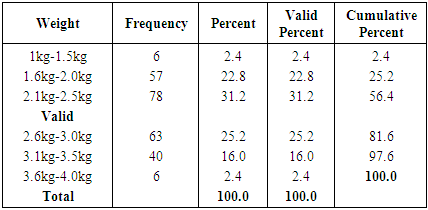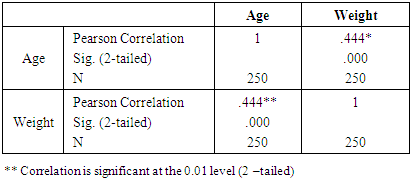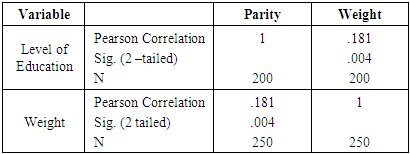-
Paper Information
- Paper Submission
-
Journal Information
- About This Journal
- Editorial Board
- Current Issue
- Archive
- Author Guidelines
- Contact Us
Public Health Research
p-ISSN: 2167-7263 e-ISSN: 2167-7247
2019; 9(2): 39-42
doi:10.5923/j.phr.20190902.03

Socio Metric Characteristics and Neonatal Birth Weight among Women in Akoko South West Local Government Area of Ondo State
Adegboro J. S.1, Adeleke Olasunkanmi R.1, Elegba Oluwatoyin2
1Department of Human Kinetics and Health Education, Adekunle Ajasin University Akungba Akoko, Ondo State, Nigeria
2National Open University of Nigerian, Nigeria
Correspondence to: Adegboro J. S., Department of Human Kinetics and Health Education, Adekunle Ajasin University Akungba Akoko, Ondo State, Nigeria.
| Email: |  |
Copyright © 2019 The Author(s). Published by Scientific & Academic Publishing.
This work is licensed under the Creative Commons Attribution International License (CC BY).
http://creativecommons.org/licenses/by/4.0/

The study investigated socio metric characteristics and neonatal birth weight among women in Akoko South west local Government area of Ondo State. This study made use of five randomly selected health facilities in Akoko south west Local Government Area engaging in delivery of babies. Consequently, a total of 250 women (patients) cards were sampled using simple randomly sampling technique, consisting of women that delivered babies between July 2017 and April 2018. The study was carried out using descriptive survey research design of ex-post facto. A questionnaire was used to obtain relevant information from the cards obtained. This study revealed that 25.2% of the respondents had low birth weight. The study revealed that age, parity and level of education have significant relationship with pattern of neonatal birth weight among women in Akoko south west. While maternal religion was not significant. Based on these, it is suggested that health education programs should also target towards creating awareness about proper age for marriage and conceiving Improvement in socio-economic indices, and better quality ANC services.
Keywords: Maternal, Maternal Health, Neonatal, Mortality and Morbidity, Pregnancy and Body Mass Index (BMI)
Cite this paper: Adegboro J. S., Adeleke Olasunkanmi R., Elegba Oluwatoyin, Socio Metric Characteristics and Neonatal Birth Weight among Women in Akoko South West Local Government Area of Ondo State, Public Health Research, Vol. 9 No. 2, 2019, pp. 39-42. doi: 10.5923/j.phr.20190902.03.
1. Introduction
- Socio or social refers to relation with others or things in the society as metric deals with measurement of things, while neonatal simply refers to the period of time that immediately following birth especially one less than one month old. Health features have changes across women in child bearing age and are affecting both maternal and neonatal outcomes. Women are entering maternity with a higher body mass index (BMI) and age hence at a high initial body weight. On the other hand, obesity, a growing global health problem, is affecting a high percentage of young women with a negative impact on their own maternal health [1]. They further revealed that indicators showed respectively a prevalence of 4.5% and 53.7% of women having a pregnancy body mass index in the underweight and overweight categories respectively. Weight gain indicators during pregnancy are as a result of pre-pregnancy body mass index are and gestational weight gain (GWG). During the last decades, researchers study the influence of those parameters on the development of maternal and neonatal complications such as gestational diabetes, pregnancy induced hypertension, caesarean and preterm delivery. The main contributors of this excess adiposity are the intake of high energy foods and sedentary lifestyles [2].Pregestational body mass index and gestational weight gain had increased worldwide and women characteristic had changed regarding their weight gain [3]. Birth weight is the first weight of the foetus or infant obtain after birth and should be measured during the first hours of birth, before the appreciable postnatal loss of weight occurs. Also, the large proportion of home births creates huge gap in birth weight information. This widespread problem is a reflection of the lower socio-economic status of rural and sub urban women affecting their nutritional status. At both ends of the age spectrum, the relationship between age and adverse offspring outcome may be in opposite directions, with the association between having a baby as a teenager and adverse perinatal outcomes possibly being explained by low socio-economic position and the generally higher socio-economic position/pattern of older mothers concealing a biological effect of older maternal age or poor offspring outcomes [4]. [5] Stated that it has been well established that increased maternal education, income, and social status contribute to increase in birth weight as well as reduced risk for low or very low birth weight offspring.It has been observed that maternal religion attendance is protective against low birth weight. In fact, each unit increases in the frequency of religion attendance reduces the odd of low birth weight. The religion attendance protect against negative birth outcomes like low birth weight and infant mortality [6]. A large and ever expanding body of research indicates that religious attendance tends to favor health and longevity within individuals [7, 8]. Previous research has identified several explanations that are at least theoretically viable [9]. Low birth weight is influenced by many socio-economic factors like habitat, urban and rural education birth order, substance abuse by mother, religion, age of mother, nutritional status of mother body mass index, heamoglobin level among others [10].Maternal parity is a well-recognized predictor of infant birth weight, with the lowest birth weight observed among children born to multiparous women [11]. The society is over charged with this low birth weight among the women at different categories of age. This problem is due to different factors or reasons which unfortunately affect the foetus and the children at different states of their lives [12]. The prevalence of low birth weight in Nigeria has been put previously at 16%, 12% and 14% [13, 14]. Every single day, Nigeria loses about 2,520 under-five year olds. This may be associated with the incidence of low birth weight in the country, thus making the country the second largest contributor to under-five mortality in the whole world [15].In view to correct these negative occurrences, there is need to find out the relationship between socio metric characteristics and neonatal birth weight among women, the need to generate such data is the problem of this study. Based on this background, the researchers wish to assess the socio metric characteristics and neonatal birth weight among women in Akoko South West Local Government Ondo State.Research Question1. What is the pattern of neonatal birth weight among women in Akoko South West of Ondo State?2. What is the relationship between Age, Religion, Parity and level of education of mother and pattern of neonatal birth weight among women in the study Area.Research Hypotheses1. Age will not have any significant relationship with pattern of neonatal birth weight among women in Akoko South West.2. Religion will not have any significant relationship with pattern of neonatal birth weight among women in Akoko South West.3. Parity will not have any significant relationship with pattern of neonatal birth weight among women in Akoko South West.4. Education will not have any significant relationship with pattern of neonatal birth weight among women in Akoko South West.Method of the studyDescriptive survey research design of ex-post facto type was adopted for the study. The population of the study comprised of all women who are in child bearing age in Akoko South West Local Government Area of Ondo State. The sample for this study comprises two hundred and fifty (250) women. Fifty (50) women cards were randomly selected from each of the five health facilities which were randomly selected from the population to participate in the study. The sample was drawn from July 2017 to April 2018 from the selected five health facilities. The research instrument for the study is questionnaire. The research instrument was given to two experts who made necessary suggestions to ensure the face and content validity, corrections were effected and the final copy was produced. The reliability of the instrument was assumed to be one. This is because the researcher generated the data from the medical record of the health facilities. This record is not expected to change over time. The questionnaire was personally administered by the researchers, data collected from the study was analyzed with SPSS using frequency count and percentages to answer the research questions while inferential statistics were used to test the hypotheses. Alpha was set at 0.05 level.
2. Result and Discussion
- Research question 1: What is the pattern of neonatal birth weight among women in Akoko South West Local Government Area of Ondo State.
|
|
|
|
|
3. Conclusions
- There is significant relationship between age, parity and level of education. While there was no significant relationship between religion and neonatal birth weight.
4. Recommendations
- The following recommendations are made:1. Health education programs should also target towards creating awareness about proper age for marriage and conceiving.2. Height is an un-modifiable characteristic but mothers should be counseled regarding importance of adequate pre-pregnancy weight and weight gain during pregnancy through healthy eating habits.3. Public health professionals and policy makers to implement strategies or intervention programs to reduce the prevalence of LBW in the future.4. Improvement in socio-economic indices, and more and better quality ANC services.5. Religious leaders should be educated on factors related to neonatal birth weight so that they can in return educate members of their assemblies.6. Women education should be encouraged as this will enhance improvement of neonatal birth weight.
 Abstract
Abstract Reference
Reference Full-Text PDF
Full-Text PDF Full-text HTML
Full-text HTML



